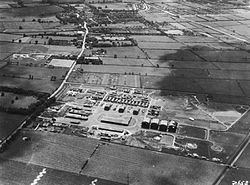Owner Air Ministry Year built 1938 | In use 1939-1961 | |
 | ||
Type Royal Air Force station17 Balloon CentreRAF School of FirefightingNo 3505 Fighter Control Unit | ||
Royal Air Force Sutton on Hull was a Royal Air Force station situated in the suburb of Sutton-on-Hull (part of Kingston upon Hull) in the East Riding of Yorkshire that operated from 1938 to 1961. During the Second World War, its primary role was to operate as no 17 Balloon Centre of 33 Group (under RAF Balloon Command) which was headquartered in Sheffield. The balloons deployed from here were used as part of the defensive tactics against Luftwaffe bombing raids on Hull, Hull Docks, Grimsby and the wider Humber area.
Contents
After the war, the base was home to the Royal Air Force Fire and Rescue School before it moved to Royal Air Force Catterick in 1959. The site of the station is now part of the Bransholme estate.
History
Construction of the base started in late 1938 and by early 1939, it was ready to be occupied with official opening coming on 28 June 1939. The base was renamed RAF Sutton on Hull in October 1942 when No 17 Balloon Centre was disbanded.
The operational aspect of the Balloon Centre consisted of 3 Royal Auxiliary Air Force (RAuxAF) Squadrons; No's 942, 943 & 944 (East Riding) Balloon Squadrons. Each Squadron consisted of 5 flights with 9 balloons. Each balloon was crewed by a Corporal, 10 Airmen of the RAuxAF and 1 regular Royal Air Force Balloon operator. The base was commanded by No. 33 Group (part of Balloon Command) which was headquartered in Sheffield. The three squadrons collectively were allotted 72 balloons between them.
During the war, some of the Squadrons became staffed by the Women's Auxiliary Air Force whilst in 1944, No's 942 and 943 Squadrons amalgamated into 942/3 Squadron. Later in the same year, No 944 squadron was disbanded and No 942/3 squadron was moved south to London as part of the Anti-Diver Barrage against the V1 Flying Bombs.
All of Balloon Command became redundant towards the end of 1944 with the cessation of barrages and in February 1945, Balloon Command was officially disbanded.
In August 1943, the Royal Air Force School of Fire Fighting and Rescue inaugurated training at RAF Sutton on Hull. Training continued throughout the war and afterwards with the school being awarded its own badge in December 1953. In 1955, the trade came under the umbrella of the RAF Regiment (Trade Group 22) and as a result, four years later the school was moved to Royal Air Force Catterick where the RAF Regiment training and HQ were located.
RAF Sutton on Hull was also the location of No 3505 Fighter Control Unit between 1947 and 1961. The FCU was awarded its own badge in 1951 which is the White Rose of York with four equal sparks of lightning emanating from behind the rose. The motto of the unit was Intercipere et delere which translates as [to] Intercept and Destroy. The FCU's were created to work with the RAuxAF Fighter Squadrons, but as these were disbanded in 1957, so too were the FCU's wound up.
Lodger units
Besides the three main units operating from RAF Sutton on Hull, various lodger units were allocated there over the course of its operational history. These were;
Post war
In 1947, one of the buildings on the camp was broken into and various items were discovered to be missing. Due to the harmful nature of the missing items (phosphorus grenades, tear gas generators and chloropicrin), the local police actually took to the streets with loudhailers warning of the inherent danger of the missing items and appealing for their return.
After the School of Fire Fighting was relocated, the site was finally closed and most of the estate was sold off to Hull Corporation in 1961.
Only No 3505 FCU and the RAF School of Fire Fighting were issued with approved badges. RAF Sutton on Hull just displayed whichever command or group that it resided under at that time.
Modern day
The site of the Balloon Centre is now part of the Bransholme estate. The Bransholme estate is believed to be the largest Council estate in Yorkshire. The main gates to the base were re-hung at Hull East Park and renovated in 1999 to commemorate the 60th anniversary of the site being opened.
